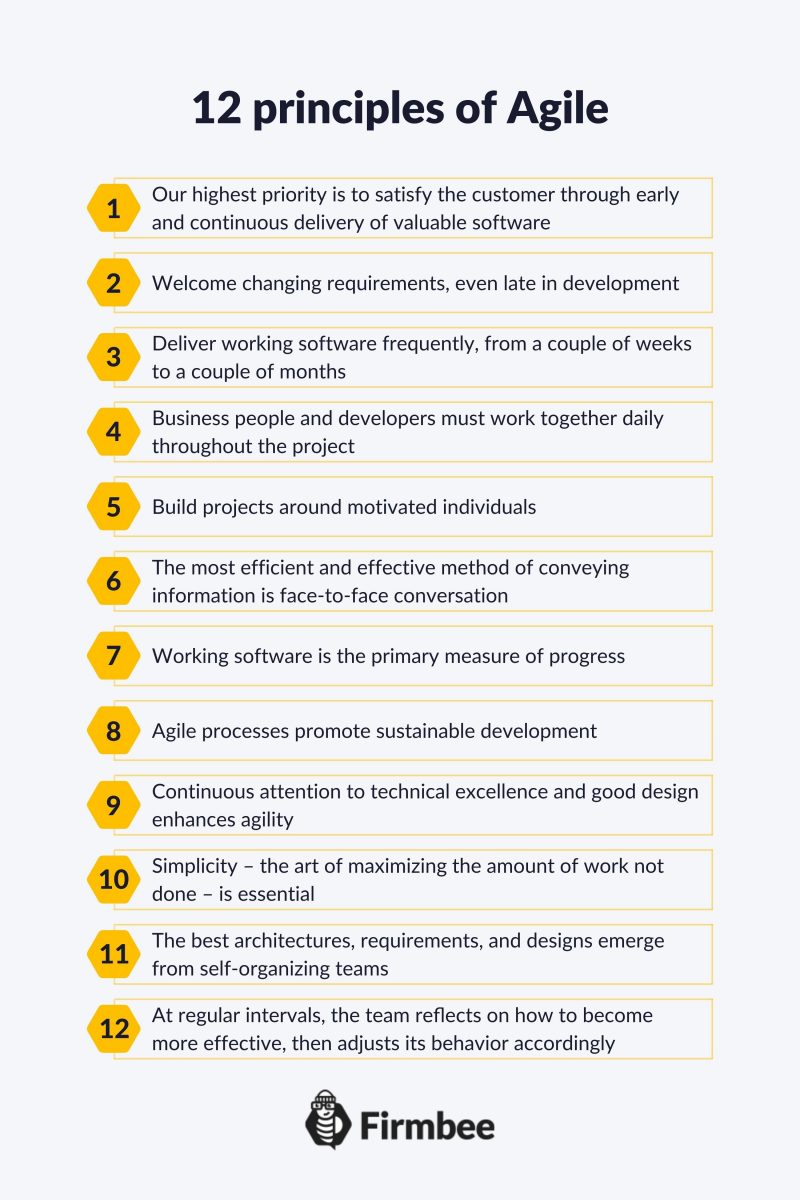The Agile Manifesto consists of 12 principles that define the agile approach to software development. Nowadays, the agile approach clearly outlines the rules for teamwork in the IT industry. It can be considered the most successful and effective methodology of lightweight project management. What are the pros and cons of using agile project management?
12 principles of Agile – table of contents:
12 principles of Agile
Agile project management is based on rules that are clearly stated and easy to remember. In addition to the four values we described in this text, the Agile Manifesto consists of 12 principles of Agile.
Below, we will present the pros and cons of 12 principles of Agile. We will discuss them one by one, as presented in the latest version of the Agile Manifesto published in 2019. They are as follows:
- Our highest priority is to satisfy the customer through early and continuous delivery of valuable software.
- Welcome changing requirements, even late in development. Agile processes harness change for the customer’s competitive advantage.
- Deliver working software frequently, from a couple of weeks to a couple of months, with a preference to the shorter timescale.
- Business people and developers must work together daily throughout the project.
- Build projects around motivated individuals. Give them the environment and support they need, and trust them to get the job done.
- The most efficient and effective method of conveying information to and within a development team is face-to-face conversation.
- Working software is the primary measure of progress.
- Agile processes promote sustainable development. The sponsors, developers, and users should be able to maintain a constant pace indefinitely.
- Continuous attention to technical excellence and good design enhances agility.
- Simplicity – the art of maximizing the amount of work not done – is essential.
- The best architectures, requirements, and designs emerge from self-organizing teams.
- At regular intervals, the team reflects on how to become more effective, then tunes and adjusts its behavior accordingly.
Setting the highest priority to fast product delivery is a major advantage from the client’s point of view. The first working version of the product can be released just after it meets the agreed criteria. The team works fast on the next updates that can be launched even every day. This way, the product is always new and always working.
However, the approach also has some downsides, as the product is always under development. Hence, the older versions purchased by end users can become incompatible pretty quickly, or demand continuous update to perform correctly.
When the team is able to embrace changing requirements, the product can be adjusted quickly and effectively to the client’s and market’s needs. The challenging environment boosts creativity, and can lead to innovation. However, harnessing change is not only exciting, but also very demanding for the team. They need to learn on an everyday basis, and be open to frequent situations, when solutions they developed are not to be continued, or even not implemented into the product at all.
The rule of frequent delivery is very important for a highly competitive and rapidly changing market environment. It also makes the team avoid developing side functionalities of the product, and focus on the major goals set by the customer.
Nevertheless, when some major changes in the product are planned, this rule should not be followed very strictly. In this case, it is better to test the new solution thoroughly than release an unfinished version of the product.
Close cooperation between the business and development teams is crucial for delivering a valuable product to the market. The problems that can emerge here are with communication and expectations. The reason is that development teams are not always able to communicate the technical limitations of their solutions. Business partners, in turn, may struggle to clarify their expectations, which may rise or become undefined.

Mutual trust between members of the team, as well as a healthy dose of freedom, are the necessary elements of a successful and efficient work. When the motivated team feels responsible for the work to be done, they usually concentrate their efforts to get the job done. Nevertheless, this project management approach requires a proper balance between independence and control. The team needs an open environment to be creative, but it also needs the limits to work towards goals.
Face-to-face conversations are mostly replaced by online meetings nowadays. We need to remember that the Agile Manifesto was written in 2001, when remote work was not as common as it is today, and possibilities of online meetings were pretty limited. However, face-to-face meetings, or just video conferences, are very important to keep the team motivated. However, this is a time-consuming solution. Hence, agile project managers often limit the timeboxes, and moderate the course of the meeting.
A new version of working software, or other potentially market-ready product, are definitely the best measures of progress. However, at times, some maintenance works need to be performed. Hence, this principle cannot be taken literally in every single case.
Sustainable development means the ability of the team to estimate their own capacity. This is one of the most important measures of a mature team. As long as the team should not work in its full capacity all the time, there are some special moments in a life cycle of the product, when such periods as e.g. crunch, are necessary.
Technical excellence means no need to perform time- and resources-consuming revisions. And this is one of the most important reasons for paying continuous attention to the quality of the developed product. In the case of this Agile principle, we are not able to point out any cons of this approach.
The 10th principle of Agile can be expressed in a well-known saying “Work smarter, not harder”. In other words, if some functionality of the product is not going to be released, do not work on it. The con of this approach is the need for a great project manager, who is able to prioritize the job in a real time, and adjust its scope to client’s demands.
Self-organizing teams feel responsible for their work, as they cannot say that the failure is a result of bad governance or dated supervision. However, more junior teams often need some coaching or mentoring. Hence, in the beginning, it can be considered to work with an experienced Scrum Master, whose role is described here, or other kind of Agile coach.
Reflection and adaptation are the basics not only for general agile approach, but also are the foundations of the Scrum framework. It is very hard to find some downside for this adaptive approach, as reflecting on teamwork usually leads to better efficiency, as well as team integration.

Summary
Agile was created as a software development methodology that emphasizes iterative development, team collaboration, and customer feedback. The Agile Manifesto outlines 12 principles of Agile that guide agile project management. They focus on delivering value to the customer through continuous delivery of working software.
The agile approach has many pros; it is a fast and continuous process that is designed to follow the changing needs of the customer. It is responsive to the market and provides a high degree of flexibility.
Now that you know the 12 principles of Agile, you can check out how to use Agile methodology for freelance projects.
If you like our content, join our busy bees community on Facebook, Twitter, LinkedIn, Instagram, YouTube, Pinterest.
Author: Caroline Becker
As a Project Manager, Caroline is an expert in finding new methods to design the best workflows and optimize processes. Her organizational skills and ability to work under time pressure make her the best person to turn complicated projects into reality.


















